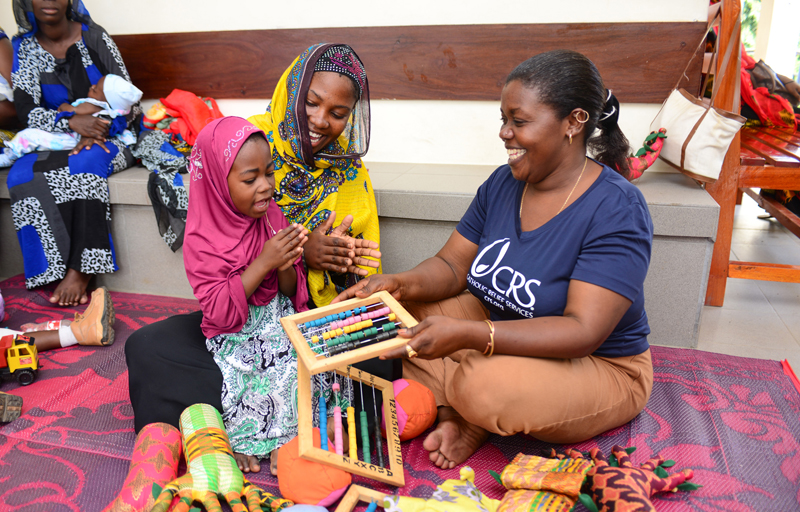By Barb Arland-Fye
The Catholic Messenger
Randy Meier, the director of Seniors vs. Crime for Clinton County, was doing some research for his job when he ran across information on the Charity Navigator website about a Catholic nonprofit. He was disappointed to learn that the organization is listed among the “Ten Charities with High CEO Compensation and Low Results.”
“It never looks good when something identifies itself as Catholic and gets that kind of attention,” Meier said in an email to The Catholic Messenger.
With charitable organizations making a push for donations before the end of the year, donors should take time in choosing which charities will be the best stewards of their contributions. “There are scores of causes, supported by literally thousands of organizations. We can’t support them all,” Meier said. “Do some reflection: ‘What are the things most important to me? Where do I want to make a difference? What is my passion?’”

Four-year-old Saumu plays at a Catholic Relief Services childhood development center in Tanga, Tanzania. Saumu’s sister Rehema, in yellow, brings her to the center. At right is a CRS worker.
He noted that Charity Navigator, Better Business Bureau’s Giving Alliance, Charity Watch and Guidestar all use rating systems to evaluate non-profits. After you choose a rating system, review how much the charity pays its CEO in relation to the overall budget and what percentage of funds is spent on fundraising. “I think we want most of our money to benefit the mission, not to pay professional fund-raisers, or just to perpetuate the existence of the organization,” Meier said.
Charity Navigator identifies itself as the largest independent evaluator of U.S. charities and reviews more than 8,000 organizations a year (www.charitynavigator.org). The information is easily accessible and based on information that a charity provided in its report to the IRS.
Catholic Medical Mission Board (CMMB), a non-governmental organization working to improve health care for the world’s poor, ranks sixth of 10 of the best charities everyone’s heard of, according to Charity Navigator. CMMB scored 97.23 on a scale of 100. CMMB spends just 1.5 of its total expenses for administration. CEO Bruce Wilkinson earned $354,485 in Fiscal Year 2014, or 0.09 percent of expenses. The agency reports that nearly 98 percent of expenses go toward programs focused on saving the lives of children and mothers by concentrating on leading causes of mortality in targeted communities throughout Africa, Latin America and the Caribbean.
Catholic Charities USA, which offers support to member agencies, provides disaster relief and promotes poverty-reduction through research and legislative reform, received a score of 93.52 from Charity Navigator. Administrative expenses totaled 14.8 percent in 2014, while expenses devoted to programs totaled 78.2 percent. Then-president/CEO Father Larry Snyder earned $338,956 (1.02 percent of expenses) and Executive Vice President, Chief Operating Officer Keith Styles earned $374,467 (1.12 percent of expenses).
Catholic Relief Services (CRS), which carries out the commitment of the U.S. bishops to assist the poor and vulnerable overseas, scored 85.18 with Charity Navigator. While the ranking is not as high (results are based on a number of financial and non-financial factors), CRS devotes 92.3 percent of expenses toward the programs and services it delivers. Administrative expenses totaled 3.3 percent. In fiscal year 2015, CRS President Carolyn Woo earned $418,368, or 0.05 percent of expenses.
Dan Timmons, an Edward Jones financial advisor in Davenport says he asks his clients, “What do you want to see your money do or who do you want to help with that money?” He also encourages clients to “think about your local parish or Catholic school, from a standpoint of contributions going where (you can see) your dollars work.”
Diocesan Development Director Andy Gaertner noted, “Our local churches aren’t necessarily going to show up on Charity Navigator, and yet there’s a huge need.” Diocesan charitable entities do go through a financial review process on a regular basis to ensure that the funds are being used as the donors intended, he added.
The diocese and the Catholic Foundation for the Diocese of Davenport, as nonprofit corporations, undergo external audits annually, said Diocesan Chief Financial Officer Nikki Gartner. Part of the process includes a review of charitable collections, such as the Catholic Foundation’s seminarian appeal, to ensure that the funds are spent as designated and promoted.
If parishes have questions about monitoring charitable funds, “we will come out and perform an audit,” Gartner said. Nancy Karn, the diocese’s accounting coordinator, will also conduct an internal audit when a new priest or bookkeeper arrives in a parish. “When you give money and restrict it toward a particular ministry in the diocese, that money goes to that ministry. We take that very seriously,” Gartner said.
Kent Ferris, director of Social Action and of Catholic Charities for the Davenport Diocese, said donations to the local Catholic Charities help individuals unable to pay for legal assistance in the diocesan Immigration Office. Funds also go toward Project Rachel (a post-abortion ministry) and diocesan-wide gatherings of parish nurses.
“Parishes also have collections as far as local needs and are incredibly generous in responding to charitable needs in their communities without great fanfare and also do so with great knowledge. They know the local communities better than we do,” Ferris added.
Charitable donations and seniors
When an individual reaches age 70-1/2, he or she generally has to start taking withdrawals from their IRA, SIMPLE IRA, SEP IRA or retirement plan account, according to the IRS. These withdrawals are considered taxable income except for any part that was taxed before or that can be received tax-free. Another option: gift the money out of the IRA to a qualifying charity and receive a tax deduction on your federal tax return.
“A lot of folks choose to give to the local parishes, which is very good, or to the Mississippi Valley Student Tuition Organization (STO). They get a state tax credit equal to 65 percent of the total contribution to the STO and a federal deduction, said Dan Timmons, an Edward Jones financial advisor.
STOs are charitable organizations that raise tuition grant funding for eligible students who enroll in accredited nonpublic schools in Iowa. The Mississippi Valley STO covers Scott County Catholic schools and Rivermont Collegiate in Bettendorf. The Student Tuition Organization of Southeast Iowa covers schools outside of Scott County.











